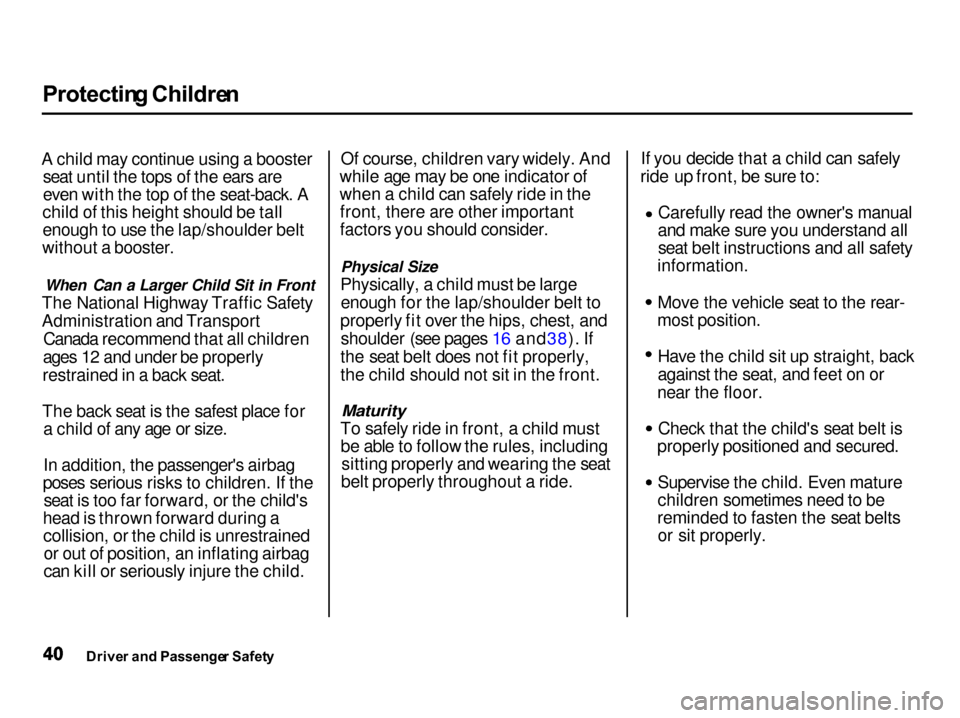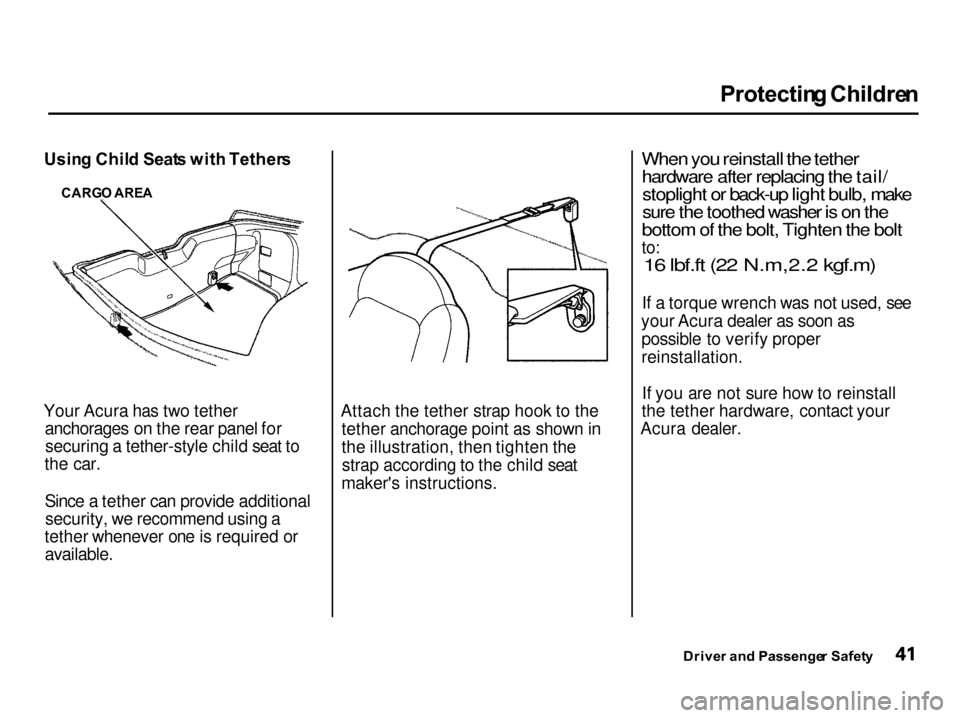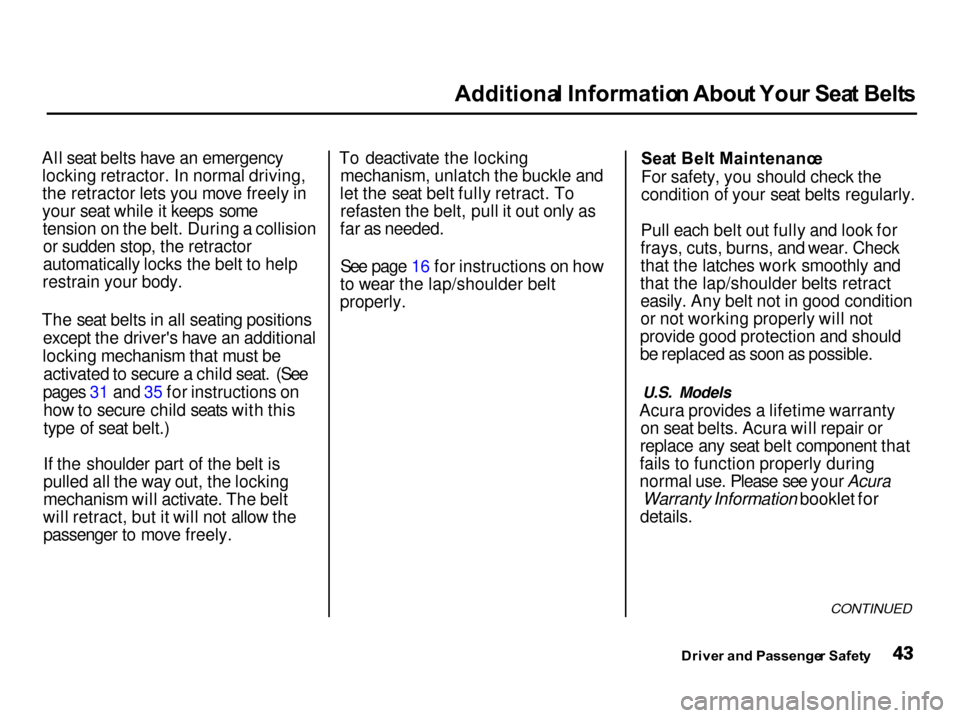ECU Acura Integra 2001 User Guide
[x] Cancel search | Manufacturer: ACURA, Model Year: 2001, Model line: Integra, Model: Acura Integra 2001Pages: 285, PDF Size: 3.79 MB
Page 39 of 285

Protectin
g Childre n
2. To activate the lockable retractor, slowly pull the shoulder part of the
belt all the way out until it stops,
then let the belt feed back into the
retractor (you might hear a clicking noise as the belt retracts). 3. After the belt has retracted, tug on
it. If the belt is locked, you will not
be able to pull it out. If you can pull
the belt out, it is not locked and
you will need to repeat these steps.
4. After confirming that the belt islocked, grab the shoulder part of
the belt near the buckle and pull up to remove any slack from the
lap part of the belt. Remember, if
the lap part of the belt is not tight,
the child seat will not be secure. It
may help to put weight on the child seat, or push on the back of
the seat, while pulling up on the
belt.
Drive r an d Passenge r Safet y
Page 40 of 285

Protectin
g Childre n
5. Push and pull the child seat forward and from side to side to
verify that it is secure enough to stay upright during normal driving
maneuvers. If the child seat is not secure, unlatch the belt, allow it to
retract fully, then repeat these
steps.
To deactivate the locking
mechanism in order to remove a
child seat, unlatch the buckle,
unroute the seat belt, and let the belt
fully retract.
Additional Precautions for Small
Children
Never hold a small child on your
lap. If you are not wearing a seat
belt in a crash, you could be
thrown forward into the dashboard and crush the child.
If you are wearing a seat belt, the
child can be torn from your arms
during a crash. For example, if
your car crashes into a parked
vehicle at 30 mph (48 km/h), a 30-lb (14 kg) child will become a
900-lb (410 kg) force, and you will
not be able to hold on.
Never put a seat belt over yourself
and a child. During a crash, the
belt could press deep into the child and cause very serious injuries.
Drive r an d Passenge r Safet y
Page 43 of 285

Protectin
g Childre n
A child may continue using a booster seat until the tops of the ears are
even with the top of the seat-back. A
child of this height should be tall
enough to use the lap/shoulder belt
without a booster.
When Can a Larger Child Sit in Front
The National Highway Traffic Safety
Administration and Transport Canada recommend that all children
ages 12 and under be properly
restrained in a back seat.
The back seat is the safest place for a child of any age or size.
In addition, the passenger's airbag
poses serious risks to children. If the seat is too far forward, or the child's
head is thrown forward during a collision, or the child is unrestrainedor out of position, an inflating airbag
can kill or seriously injure the child. Of course, children vary widely. And
while age may be one indicator of
when a child can safely ride in the front, there are other important
factors you should consider.
Physical Size
Physically, a child must be large enough for the lap/shoulder belt to
properly fit over the hips, chest, and shoulder (see pages 16 and38). If
the seat belt does not fit properly,
the child should not sit in the front.
Maturity
To safely ride in front, a child must be able to follow the rules, including sitting properly and wearing the seat
belt properly throughout a ride. If you decide that a child can safely
ride up front, be sure to: Carefully read the owner's manual
and make sure you understand all seat belt instructions and all safety
information. Move the vehicle seat to the rear-
most position. Have the child sit up straight, back
against the seat, and feet on or
near the floor. Check that the child's seat belt is
properly positioned and secured. Supervise the child. Even mature
children sometimes need to be
reminded to fasten the seat belts or sit properly.
Drive r an d Passenge r Safet y
Page 44 of 285

Protectin
g Childre n
Usin g Chil d Seat s wit h Tether s
Your Acura has two tether anchorages on the rear panel forsecuring a tether-style child seat to
the car.
Since a tether can provide additionalsecurity, we recommend using a
tether whenever one is required or
available.
Attach the tether strap hook to the
tether anchorage point as shown in
the illustration, then tighten thestrap according to the child seat
maker's instructions.
When you reinstall the tether
hardware after replacing the tail/stoplight or back-up light bulb, make
sure the toothed washer is on the
bottom of the bolt, Tighten the bolt
to:
16 lbf.ft (22 N.m,2.2 kgf.m)
If a
torque wrench was not used, see
your Acura dealer as soon as possible to verify proper
reinstallation.
If you are not sure how to reinstall
the tether hardware, contact your
Acura dealer.
Driver an d Passenge r Safet y
CARG
O ARE A
Page 46 of 285

Additiona
l Informatio n Abou t You r Sea t Belt s
All seat belts have an emergency locking retractor. In normal driving,
the retractor lets you move freely in
your seat while it keeps sometension on the belt. During a collisionor sudden stop, the retractor
automatically locks the belt to help
restrain your body.
The seat belts in all seating positions except the driver's have an additional
locking mechanism that must be activated to secure a child seat. (See
pages 31 and 35 for instructions on how to secure child seats with this
type of seat belt.)
If the shoulder part of the belt is
pulled all the way out, the locking
mechanism will activate. The belt
will retract, but it will not allow the passenger to move freely. To deactivate the locking
mechanism, unlatch the buckle and
let the seat belt fully retract. To refasten the belt, pull it out only as
far as needed.
See page 16 for instructions on how
to wear the lap/shoulder belt
properly. Sea
t Bel t Maintenanc e
For safety, you should check the
condition of your seat belts regularly.
Pull each belt out fully and look for
frays, cuts, burns, and wear. Check
that the latches work smoothly and
that the lap/shoulder belts retract easily. Any belt not in good condition
or not working properly will not
provide good protection and should
be replaced as soon as possible.
U.S. Models
Acura provides a lifetime warranty on seat belts. Acura will repair or
replace any seat belt component that
fails to function properly during
normal use. Please see your Acura
Warranty Information booklet for
details.
CONTINUED
Drive r an d Passenge r Safet y
Page 70 of 285

Control
s Nea r th e Steerin g Wheel , Steerin g Whee l Control s
2. Move the steering wheel to the desired position, making sure the
wheel points toward your chest, not toward your face. Make sure
you can see the instrument panel gauges and the indicator lights.
3. Push the lever up to lock the steering wheel in that position.
4. Make sure you have securely locked the steering wheel in place
by trying to move it up and down. Cruis
e Contro l
LS, GS and GS-R models
Cruise control allows you to maintain
a set speed above 25 mph (40 km/h)
without keeping your foot on the accelerator pedal. It should be used
for cruising on straight, open
highways. It is not recommended for conditions such as city driving,
winding roads, slippery roads, heavy rain, or bad weather. You should
have full control of the car under
those conditions.
The cruise control, as it operates,
moves the accelerator pedal. You can
damage your car's accelerator
mechanism by resting your foot under the pedal and blocking the movement.
CONTINUED
Instrument s an d Control s
NOTIC
E
Improper use of the cruise
control can lead to a crash.
Use the cruise control only
when traveling on open
highways in good weather.
Page 86 of 285

Foldin
g Rea r Seat , Carg o Are a Cove r
Foldin g Rea r Sea t
The back of the rear seat folds down to give you more cargo space. Eachside folds down separately. With only
half the seat folded, you can still carry a passenger in the back seat.
To unlatch either side of the seat- back, pull up on the release tab.Move the seat belt out of the way
and fold the seat-back down. To lock the seat-back upright, push
the seat-back firmly against its latch.
Tug on the seat-back to make sure it
is latched.
Do not put any heavy items on theseat-back when it is folded.
Make sure all items in the cargo area are secured. Loose items can fly
forward and cause injury if you have to brake hard. See Carryin g Carg o
on page 132. Carg
o Are a Cove r
The cargo area cover may be removed to give you more cargo
height. Place your hands, palms up, under the cover near the outside
edges. Lift it straight up.
To install the cover, line up the mounting rods with the slots, then
push down on the cover until it clips
into place. Make sure it is securely
latched so it will not come loose
while you are driving.
Instrument s an d Control s
RELEAS
E
TA B
MOUNTIN
G RO D
Page 129 of 285

Servic
e Statio n Procedure s
If you can open the hood without
lifting the hood latch handle, or the
hood latch handle moves stiffly or does not spring back as before, the
mechanism should be cleaned and
lubricated (see page 189).
SUPPOR
T RO D
CLIP
3. Pull the support rod out of its clip and insert the end into the hole on
the left side of the hood. To close the hood, lift it up slightly to
remove the support rod from the
hole. Put the support rod back into its holding clip. Lower the hood to
about a foot (30 cm) above the
fender, then let it drop.
After closing the hood, make sure it is securely latched.
Befor e Drivin g
Page 136 of 285

Carryin
g Carg o
Loa d Limi t
The maximum load for your car is
700 lbs (325 kg).
This figure includes the total weight of all occupants, cargo, accessories,
and the tongue weight if you are
towing a trailer.
To figure out how much cargo you can carry: Add up the weight of all occupants.
If you are towing a trailer, add the
tongue weight to the number
above.
Subtract the total from 700 Ibs
(325 kg).
The final number is the total weight
of cargo you can carry.
Carryin
g Item s i n th e Passenge r
Compartmen t Store or secure all items that could
be thrown around and hurt someone during a crash. Be sure items placed on the floor
behind the front seats cannot roll
under the seats and interfere with
the driver's ability to operate the
pedals, or with the proper operation of the seats. Keep the glove box closed while
driving. If the lid is open, a
passenger could injure their knees during a crash or sudden stop.
Before Drivin g
Overloading or improper
loading can affect handling and
stability and cause a crash in
which you can be hurt or killed.
Follow all load limits and other
loading guidelines in this
manual.
Page 139 of 285

Preparin
g to Driv e
You should do the following checks and adjustments every day before
you drive your car.
1. Make sure all windows, mirrors, and outside lights are clean and
unobstructed. Remove frost, snow,or ice.
2. Check that the hood and hatch are fully closed.
3. Visually check the tires. If a tire looks low, use a gauge to check its
pressure.
4. Check that any items you may be carrying with you inside are stored
properly or fastened down
securely.
5. Check the adjustment of the seat
(see page 79 ).
6. Check the adjustment of the inside and outside mirrors (see
page 86 ).
7. Check the adjustment of the steering wheel (see page 66 ).
8. Make sure the doors and hatch
are securely closed and locked.
9. Fasten your seat belt. Check that
your passengers have fastened
their seat belts (see page 16 ). 10. Turn the ignition switch ON (II).
Check the indicator lights in the
instrument panel.
11. Start the engine (see page 137).
12. Check the gauges and indicator lights in the instrument panel (see
page 53).
Drivin g